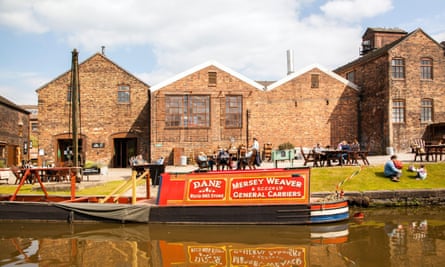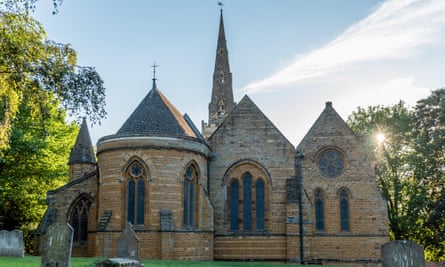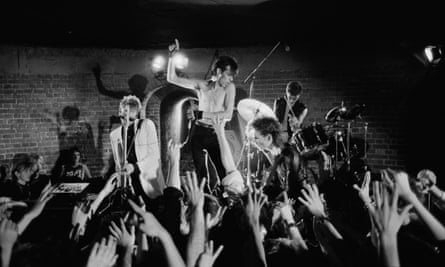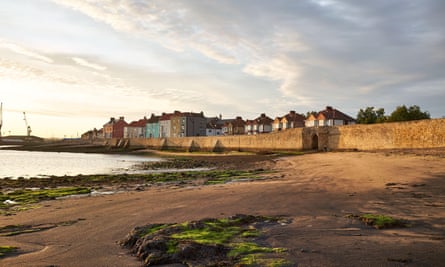Frontier towns are bypassed, forgotten, often forlorn, occasionally vicious in the old sense of the word: full of vice. Seediness inhabits their edges, and edges are what they mainly are. Meant to be bulwarks or limits, they are usually porous and uncertain. Travellers pause before making their next move. Frontiers have caused a lot of trouble in the UK. The Channel, Offa’s Dyke, Hadrian’s Wall and Northern Ireland’s border with the Republic have been sites of tension, trouble and illicit trade, but there are edges to all cities and regions, and every seaside resort is a border. This quintet of places rarely chosen as holiday destinations are the kinds of towns Graham Greene might have used as backdrops for his novels and short stories if he’d been a working-class writer instead of a public schoolboy with a colonial complex. They’re probably familiar to most non-natives mainly as road signs, “via” places, stepping stones, but all are worth a linger and a look around.
Stoke-on-Trent

Stoke is not only edges; it’s the UK’s only polycentric city. Hanley claims to be the city centre, and has the Primark, TK Maxx, banks and bus station to prove it. But Stoke should rotate this honour, the way other cities pass round their mayoral chain. Why shouldn’t any of the other four centres – Burslem, Tunstall, Fenton and Longton – put in a shift? There’s even a place called Stoke-upon-Trent, commonly called Stoke, inside Stoke-on-Trent (thus Stoke-on-Trent station, the main one, is in Stoke-upon-Trent). To this madness of nomenclature and borough fragmentation, we can add the fact that the five, or six, towns merge into Newcastle-under-Lyme to the west, making the latter’s contours and clamour indistinguishable from Stoke’s. No green belt has curbed this coalescence.
Arguably, the whole of the Midlands could be construed as a region intended to confuse and defy in a country obsessed with cardinal points. But Stoke is special. It is east and west, north and south, and none of these. Take a look at a map of the River Trent, a lopsided U sometimes said to denote a border, with Stoke at its shorter tail-end. This city is 25 miles from Wales but its river empties into the North Sea via the Humber.
High on disorientation, I drove around like a JG Ballard cipher. Searching for old pots was like archaeology rather than sightseeing. Where were the sherds and wheels? I saw a promising old factory but it was too late to turn round. I plugged Wedgwood into the satnav and was sent to purgatory – a weird semi-private estate, the opposite of the kind of place where you want to potter. Eventually, I found a surviving authentic craft centre: Middleport in Burslem, “the Mother Town of the Potteries”. Here were dirty redbrick buildings, bottle-shaped kilns and a canteen selling bowls of lobby – a delicious Staffordshire stew a bit like the scouse eaten in my own native Lancashire. A barge on the canal was emblazoned “Mersey Weaver”; the poshest bowls and plates once went to Liverpool for the liners. China clay came from Cornwall. Stoke was the centre of a ceramics universe. Middleport is home to a proper, serious training school. I bought a couple of beautiful bowls, which I love too much to stain with soup. Apparently, The Great Pottery Throw Down led to a recent mini-wave of new tourists. Good for them. Stoke needs visitors. What are all those roads for, after all?
Things to see: The Potteries Museum & Art Gallery in Hanley, and the Arnold Bennett statue outside; the Stanley Matthews statue at Stoke City stadium
Newport

Everybody takes away a different abiding memory from a place. My Newport memory has always been the brown Usk, which seems to be at low tide whenever I arrive by train. Under leaden skies, this corner of Wales specialises in the deep, mud-walled trough that looks like an industrial waste sluice, a forgotten canal, a giant’s ditch. After the magnificence of the Severn Bridge, or the Black Hills, it seems a despondent sort of border. But then I reflect on what the river has seen on its way down from Bannau Brycheiniog national park. No amount of spring water can wash away Newport’s dirty past.
Being in Wales and close to England, Newport, of course, once had a castle – the remains are discarded beside the main B4591 road and the railway bridge. In olden times, it was the seat of a Marcher lordship, from mereg or Latin margo: margin, boundary. A medieval ship was found buried in the west bank of the Usk in 2002, probably built in the Basque region and plying lanes between Wales and Portugal.
Newport’s golden age, which was mainly black and grey, was the industrial period, when it became one of the most important places in the country for exporting coal and smelting iron. Grievances among the workers doing all the hard work led to the 1839 Chartist Rising, said to be the last armed confrontation inside Wales. Docks were built from the 1840s, and greatly expanded over the years. In 1914, Newport shipped more than 6m tons of coal a year. The docks, old bridges and lighthouse feature in a 23-mile section of the Wales Coast Path. Newport is still a sort of industrial centre, now making tiny things such as semiconductors and microelectronics. A former coal magnate’s mansion is occupied by Celtic Manor, the mega-sized golf hotel that looms over the M4. Here, the chipmaking managers come to drive and pot.
A Roman-era pottery was found under the golf course. The area has strong connections with other ages. Across the Usk lies Carlaeon, which has Neolithic, iron age and further Roman sites. The earliest legends of King Arthur placed the seat of his kingdom not in Camelot but here. The landscape and its mythic-historic suggestiveness influenced author Arthur Machen (AKA Arthur Llewelyn Jones), born in Carlaeon in 1863. He worked as a journalist, magazine publisher, amateur historian and actor but is best remembered as an author of fantasy and horror fiction – influencing a motley mix of artists from Jorge Luis Borges and Iain Sinclair to the Fall’s Mark E Smith. Like the best fabulists of the uncanny, his fantastical writings hover at the taut edges of history and reality. While I am writing these “where tourists seldom tread” pieces, Machen’s words come to mind: “And it is utterly true that he who cannot find wonder, mystery, awe, the sense of a new world and an undiscovered realm in the places by the Gray’s Inn Road will never find those secrets elsewhere, not in the heart of Africa, not in the fabled hidden cities of Tibet.”
But Machen is only Newport’s second most interesting author. I’d never studied the statue on Commercial Street until I was reviewing a book titled Saints and Lodgers. It turned out to be a selection of poems by Newport-born WH Davies (1871-1940), known as “Super-Tramp” after another of his books, The Autobiography of a Super-Tramp – which inspired the famous prog rock band’s name. Davies boarded a steamer to cross the Atlantic and spent six years train-hopping around the US and Canada, scratching a living through casual labour and panhandling. He gained a rich experience of the wide world, but lost a leg in an accident. The statue, Stand and Stare, is a bronze sculpture evoking his freewheeling, hang-loose, hobo spirit, loosely rooted to a tree of life, with two birds ready to join him when he next takes off. Davies’s poem Leisure contains the famous line: “What is this life if, full of care, we have no time to …”.
Machen and Davies met for lunch in Newport in 1937 to celebrate the former’s 74th birthday. When I think of Newport now, I think not of the ugly lower Usk but of drifter Davies and mesmeriser Machen, sharing stories of travels astral and real.
Things to see: Fourteen Locks on the Monmouthshire Canal; Newport Market; Newport Transporter Bridge; Tiny Rebel brewery
Northampton

People used to say the band Bauhaus drove around their home town in a hearse. If their music touched on a sense of place, it was obliquely: the “flat field”, “sandwich bars and barbed wire”, the band’s name and emblem – signifying factories, functionality, hard edges. But Northampton is ancient and holy and quite strange, certainly worthy of goth attentions. It was declared a shire by Alfred the Great, and Saxons fought to remain, but the Normans came anyway. Simon de Senlis, Earl of Northampton, built a castle and, after joining the first crusade to the Holy Land, built the Holy Sepulchre (after Jerusalem’s famous shrine) – one of just four medieval round churches still standing in England.
An even more devoted pilgrim brought a “rood”, said to be a fragment of the True Cross, from near Golgotha and, following instructions from angels to place it in the centre of England, stuck it inside the wall of St Gregory’s church. The spot, off Freeschool Street, is now a car park. The late Victorian St Matthew’s church, on the Kettering Road, doubles as an art gallery: it has a Crucifixion by Graham Sutherland and a Madonna and Child by Henry Moore – both commissioned by Walter Hussey, who was its culture-loving vicar from 1937 to 1955.
Even as pilgrims came to kiss the rood, Northampton was shifting its gaze from the heavens to the ground, becoming an important centre for shoemaking. One Peter the Cordwainer is mentioned in a 1202 document. Northampton exported footwear to Flanders and by 1401 had established its own guild of shoemakers. In 1841, according to the census, there were 1,821 shoemakers across the county. Many companies were shuttered when the industry went east, but more than 30 shoemakers still operate. The local museum is home to one of the largest collections of shoes “and shoe heritage” in the world, and the football team is nicknamed the “Cobblers”. Local footy boots were more successful than the team. Bobby Charlton wore boots made by Bozeat, which later became Gola. Dedicated local people have created a shoe quarter walk that takes in abandoned, razed, overgrown and still-working factories, a leather currier’s house and an art deco cinema. The film Kinky Boots (2005), based on the story of a struggling local manufacturer saved by a sudden surge in demand from drag queens and cross-dressers, used Tricker’s shoe factory in St Michael’s Road as a location.

When I got my first job after university, I was sent to Daventry (perhaps Coventry was too good for me) to inspect a factory. I remember making small talk with a local man and remarked, in passing, that working “in the south” was something or other. The Daventrian bridled, insisting this was not the south. I mumbled something about Birmingham but he declared that he was basically a northerner. As hilarious as this sounds, the east Midlands does actually contain areas further up the map than Cheshire. I think my interlocutor was just fed up with being ignored. Northampton’s best-known author, Alan Moore, has called his town “probably … the centre of Saxon England – it was where King Offa had built his thorpe”. Northampton’s invisibility is, he says, part of its enigma. “We are the biggest town in Europe but most people are seemingly unaware that we are here.” Moore has claimed to be an incarnation of Northampton. He briefly collaborated with Bauhaus bassist David J in the band Sinister Ducks. There’s no Bauhaus-themed walking tour, but situationists might make their own by imposing a plan of Weimar or Dessau on top of this curiously overlooked county town and set off in search of the flat field.
after newsletter promotion
Things to see: Abington Park; 78 Derngate, designed by Charles Rennie Mackintosh; National Lift Tower
Stranraer

On a map, Stranraer stands out for sticking out: you have to make a concerted effort to get to it. The Solway Firth, which divides the town from Cumbria and England, also serves to thrust it out and away from Scotland. Although on the coast, Stranraer sits not beside the sea but on Loch Ryan, which further isolates it. An etymology of the town’s name is An t-Sròn Reamhar, sometimes translated as “Fat Nose”. But Stranraer is not a protuberance so much as a nostril or sinus; the nose is the peninsula called the Rhinns of Galloway. It’s far from the Highlands and any kind of heartland, more than 100 miles from Edinburgh and not even in the north. Hexham and Newcastle are closer to Shetland and the aurora borealis. The excitable epithet “out-there” was made for Stranraer.
I made my first trip in my late teens on a night train. A sleeper connected London to this hidden-away corner until 13 May 1990. A friend and I were bound for Newton Stewart to visit another friend. We didn’t pay for a sleeping compartment so sat there all night, chatting and dozing, smoking and drinking, to be cast off at dawn on to a cold, grey platform. The terminus delivered a vague end-of-something sensation. Grey mist obscured the prospect. When you are sleep-deprived, everywhere feels eschatological.
That train was called the Paddy, as it linked to the ferry to Larne in Northern Ireland. But Stranraer, which was also once connected by steam packet to Girvan and Glasgow, lost its Stena Line boats in 2011. Today, ferries depart from Cairnryan, six miles to the north. An easy stroll down to the Caledonian Princess has been replaced by a bus ride; “replaced by a bus ride” will feature in future history books of Britain’s perpetual decline.
So Stranraer is hardly a border town at all, yet in the air are crossings, collisions and incursions. Ulster Scots came from the surrounding county of Dumfries & Galloway. Genetic analysis has shown a “strong affinity for clusters of Irish ancestry” in south-west Scotland. People migrated in both directions. This was also an area occupied by Celtic Britons and Romans. Linguistically, it was once something of an exclave of the Highlands, speaking Scottish Gaelic rather than Scots. We sometimes imagine our forebears huddled, static, in huts and cottages, but they moved a lot, and Stranraer was a crossroads and beachhead.
The 16th-century Castle of St John, or Stranraer Castle, was built by the Adairs of Kilhilt, who had come from Ireland in the middle ages. It housed a military garrison during the Killing Time of the late 17th century, when local Covenanters fought with James VI and the episcopalian polity. Like Noncomformists elsewhere, Scottish Presbyterians refused to accept the authority of state-imposed bishops. The south-west, far from official power bases, was a hotspot of rebellion. A driving route honours the Covenanters’ radicalism. A moving monument is the Wigtown Stake, commemorating the martyrs Margaret Maclauchlan and Margaret Wilson, who were tied to stakes on Wigtown’s mudflats so that they drowned with the rising tide.
Curious people born and raised in edgelands may look inward and escape to the city, or else are drawn outward to the ocean. The briny air of the sea was enough to compel a young John Ross to enrol in the Royal Navy when he was just nine years old. He sailed three times to the Arctic and spent four years trapped by ice in the Gulf of Boothia in the extreme north of Canada. His home on Loch Ryan is known as North West Castle – after the fabled passage he was looking for – and functions as a hotel. Its bar was originally built as a facsimile of Ross’s cabin, which he would use as a prop while recounting his polar exploits.
Things to see: 32 Charlotte Street, former home of the Maxwells (family of author Gavin Maxwell); North West Hotel ice rink (curling classes October to April); Mull of Galloway Trail
Hartlepool

“The greatest of hall-buildings” in Beowulf was Hrothgar’s mead hall. “Heorot he named it.” The name of the village of Hart may well derive from such a royal feasting hall. The name was taken up by Hartlepool – where, perhaps, deer came to drink – which grew up around an Angle settlement and an abbey sited prominently on a heugh – today’s Headland. Fishing and freight for the County Palatine bestowed on it a certain importance. Even today, Headland is a place to gulp in the sea air and views before descending into the present tense.
In 1835, a new town, West Hartlepool, expanded around the port and railway line. Energy and filth drove its rhythms, from the boom days of coal in the mid-19th century to iron and steelworks to today’s nuclear power station – infamous for being so perilously close to a major conurbation. These are Hartlepool’s Pillars of Hercules: EDF’s big grey box of fissile uranium and St Hilda’s church, occupying the ghost-space where the abbey stood. Between them runs the England Coast Path, which provided my first welcome to Hartlepool, with dunes, skylarks and the wreck of the schooner Doris at Seaton Carew.
For a spell the twin-township was known as Hartlepools. To keep things consistent, Hartlepools United football club absorbed West Hartlepool. It still had that name when Brian Clough joined the faltering side in 1965 in his first stint as a manager. He toured local pubs, clubs, fetes and school parties to raise money for kit and ground improvements, but it was only when he left that the team improved. In his 2008 book The Damned United, author David Peace writes: “Hartlepools United have been promoted to Division Three – Broken hearts and salted wounds.”
It was all change in 1968, when West Hartlepool, “Old” Hartlepool and Hart merged into the new borough of Hartlepool. No more deer. But are the remains of that great hall – perhaps splinters of the antlers that once hung above the entrance – interred beneath the spreading tarmac and concrete, glass and steel? I don’t know, but this coast of north-east England sometimes steals a Viking light from somewhere out east that beautifies a seafront that comprises a Premier Inn, a Brewers Fayre and a Mecca Bingo. Maritime towns dowse human clutter with their cleansing tides. Their harbours, locks and breakwaters affording sightlines to the sea, suggesting ways of escape.
Things to see: Heugh Battery Museum; National Museum of the Royal Navy

